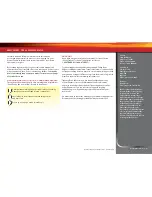
8 • SLASH 4x4
TRAXXAS TQ 2.4GHz RADIO & VELINEON POWER SYSTEM
Applying the Decals
The main decals for your
model have been applied at
the factory. The decals are
printed on self-adhesive clear
mylar and are die-cut for easy
removal. Use a hobby knife to
lift the corner of a decal and
lift it from the backing.
To apply the decals, place
one end down, hold the
other end up, and gradually
smooth the decal down with
your finger as you go. This
will prevent air bubbles.
Placing both ends of the
decal down and then trying
to smooth it out will result
in air pockets. Look at the
photos on the box for typical
decal placement.
INTRODUCTION
Your model includes the latest Traxxas TQ 2.4GHz transmitter
with Traxxas Link
™
technology. The transmitter’s easy-to-use
design provides instant driving fun for new R/C enthusiasts,
and also offers a full compliment of pro-level tuning features
for advanced users – or anyone interested in experimenting
with the performance of their model. The steering and throttle
channels feature adjustable Exponential, End Points, and Sub-
Trims. Steering and braking Dual Rate are also available. Many of
the next-level features are controlled by the Multi-Function knob,
which can be programmed to control a variety functions. The
detailed instructions (page 28) and Menu Tree (page 30) included
in this manual will help you understand and operate the advanced
functions of the new TQ 2.4GHz radio system. For additional
information and how-to videos, visit Traxxas.com.
RADIO AND POWER SYSTEM TERMINOLOGY
Please take a moment to familiarize yourself with these radio and
power system terms. They will be used throughout this manual.
A detailed explanation of the advanced terminology and features
of your new radio system begins on page 28.
2.4GHz Spread Spectrum
– This model is equipped with the latest
R/C technology. Unlike AM and FM systems that require frequency
crystals and are prone to frequency conflicts, the TQ 2.4GHz system
automatically selects and locks onto an open frequency, and offers
superior resistance to interference and “glitching.”
BEC (Battery Eliminator Circuit)
- The BEC can either be in the
receiver or in the ESC. This circuit allows the receiver and servos
to be powered by the main battery pack in an electric model.
This eliminates the need to carry a separate pack of 4 AA
batteries to power the radio equipment.
Brushless Motor
- A D/C brushless motor replaces the brushed
motor’s traditional commutator and brush arrangement with
intelligent electronics that energize the electromagnetic
windings in sequence to provide rotation. Opposite of a brushed
motor, the brushless motor has its windings (coils) on the
perimeter of the motor can and the magnets are mounted to the
spinning rotor shaft.
Cogging
- Cogging is a condition sometimes associated with
brushless motors. Typically it is a slight stutter noticed when
accelerating from a stop. It happens for a very short period as
the signals from the electronic speed control and the motor
synch with each other. The VXL-3s electronic speed control is
optimized to virtually eliminate cogging.
Current
- Current is a measure of power flow through the
electronics, usually measured in amps. If you think of a wire as a
garden hose, current is a measure of how much water is flowing
through the hose.
ESC (Electronic Speed Control)
- An electronic speed control is the
electronic motor control inside the model. The VXL-3s electronic
speed control uses advanced circuitry to provide precise, digital
proportional throttle control. Electronic speed controls use
power more efficiently than mechanical speed controls so that
the batteries run longer. An electronic speed control also has
circuitry that prevents loss of steering and throttle control as the
batteries lose their charge.
Frequency band
- The radio frequency used by the transmitter to
send signals to your model. This model operates on the 2.4GHz
direct-sequence spread spectrum.
kV Rating
- Brushless motors are often rated by their kV number.
The kV rating equals no-load motor rpm with 1 volt applied. The
kV increases as the number of wire turns in the motor decreases.
As the kV increases, the current draw through the electronics
also increases. The Velineon 3500 motor is a 10-turn, 3500 kV
motor optimized for the best speed and efficiency in lightweight
1/10 scale models.
LiPo
- Abbreviation for Lithium Polymer. Rechargeable LiPo
battery packs are known for their special chemistry that allows
extremely high energy density and current handling in a
compact size. These are high performance batteries that require
special care and handling. For advanced users only.
mAh
– Abbreviation for milliamp hour. A measure of the capacity
of the battery pack. The higher the number, the longer the
battery will last between recharges.
Neutral position
- The standing position that the servos seek
when the transmitter controls are at the neutral setting.
NiCad
- Abbreviation for nickel-cadmium. The original
rechargeable hobby pack, NiCad batteries have very high current
8









































